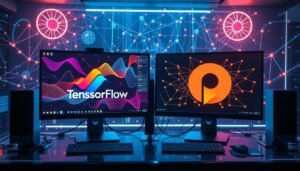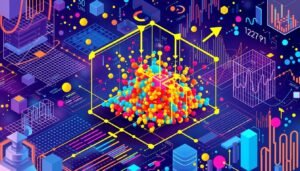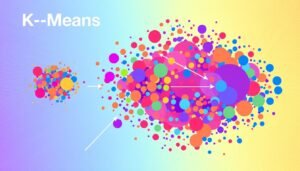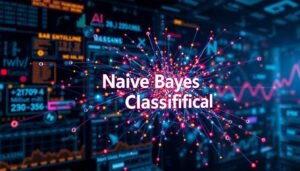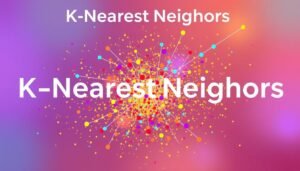Netflix’s recommendation system with wonder you. Have you ever thought about how Netflix seems to know exactly what you want to watch? The secret lies in its advanced recommendation engine. This system uses vast amounts of data and cutting-edge technology to personalize your viewing experience.
At it’s core, the engine analyzes your viewing history, ratings and even the time of day you watch. Machine learning and deep learning techniques play a crucial role in this process. They help predict what you might enjoy next, ensuring every suggestion feels tailored just for you.
This isn’t just about convenience it’s about enhancing your experience. By offering targeted video suggestions, Netflix keeps you engaged and entertained. The system’s ability to adapt and improve over time makes it a standout in the streaming world.
This section will dive into how these complex algorithms work. You’ll learn how data and AI come together to create a seamless and personalized viewing journey. Let’s explore the fascinating world behind the scenes of Netflix’s recommendation engine.
Key Takeaways
- Netflix’s recommendation system uses data and AI to personalize content.
- Viewing history, ratings, and time-of-day data drive suggestions.
- Machine learning and deep learning enhance the engine’s accuracy.
- Personalized recommendations improve the user experience.
- The system adapts and improves over time for better results.
Introduction: The Evolution of Personalized Content
The way we discover content has changed dramatically over the years. From simple ratings to complex algorithms, the journey of personalized suggestions has been nothing short of revolutionary. Today, these systems are essential tools in the digital era, helping users navigate vast libraries of media with ease.
The Rise of Recommendation Systems in the Digital Era
In the early days, users relied on basic 5-star ratings to choose what to watch. While helpful, this method lacked the depth needed to understand individual preferences. As digital platforms grew, so did the need for smarter solutions. This led to the development of advanced recommendation systems.
These systems analyze user behavior, such as viewing history and interaction patterns. By collecting and processing this datum, they can predict what a user might enjoy next. This shift from static ratings to dynamic suggestions has transformed the way we interact with content.
How Data and AI Transform Viewing Experiences
At the heart of modern recommendation systems lies data and artificial intelligence. These technologies work together to create a seamless and personalized experience. For example, machine learning techniques analyze vast amounts of information to identify patterns and trends.
This process allows platforms to offer tailored suggestions that evolve over time. The more a user interacts, the better the system becomes at predicting their preferences. This continuous improvement ensures that every recommendation feels relevant and engaging.
“The power of data and AI lies in their ability to adapt and learn, making every suggestion more accurate than the last.”
| Era | Technique | Impact on User Experience |
|---|---|---|
| Early 2000s | 5-Star Ratings | Basic, static suggestions |
| 2010s | Collaborative Filtering | Dynamic, user-based recommendations |
| Present | AI & Machine Learning | Highly personalized, adaptive content |
As the demand for data science skills grows, platforms like free data science resources are helping users understand the techniques behind these systems. This knowledge empowers individuals to appreciate the complexity and innovation driving modern content discovery.
Understanding Recommendation Engines
What makes modern platforms so good at suggesting what you’ll love? The answer lies in recommendation engines. These systems use advanced algorithms and data to predict what users might enjoy, creating a personalized experience.
What is a Recommender System?
A recommender system is a tool that analyzes user behavior to suggest products or content. It operates by collecting data like viewing history, preferences, and interactions. This data is then processed using recommendation algorithms to generate tailored suggestions.
One common method is collaborative filtering. This technique identifies patterns by comparing user behavior with others. For example, if two users have similar interests, the system might recommend products one user enjoyed to the other.
Enhancing User Engagement Through Data-Driven Decisions
Data-driven decisions are at the core of these systems. By analyzing historical data, models can predict what a customer might like next. This not only improves accuracy but also keeps users engaged by offering relevant content.
For instance, platforms use deep learning to refine their predictions. Techniques like neural networks, which you can learn more about in this deep learning guide, help process complex data for better results.
“The more data a system processes, the smarter it becomes at understanding user preferences.”
Understanding each element from the product to the model boosts the system’s efficiency. Continuous improvement ensures that every suggestion feels relevant, enhancing the overall user experience.
Netflix’s Recommendation System
Behind every personalized suggestion lies a complex blend of technology and data. This system is designed to understand your preferences and deliver content that keeps you engaged. Let’s explore how it works.

The Role of Machine Learning and Collaborative Filtering
At the core of this system is machine learning. It analyzes your viewing habits, ratings, and even the time of day you watch. This data helps the system predict what you might enjoy next.
Another key technique is collaborative filtering. It compares your behavior with others who have similar tastes. If two users like the same movie, the system might suggest titles one user enjoyed to the other.
These methods work together to create a seamless experience. The more you interact, the better the system becomes at understanding your preferences.
Leveraging Big Data and Cloud Computing for Scalability
Handling millions of users globally requires a robust infrastructure. Netflix relies on big data and cloud computing to manage this scale. The platform processes vast amounts of information in real-time to deliver accurate suggestions.
For example, the team uses AWS to ensure the system can handle peak loads without interruptions. This technical work behind the scenes ensures a smooth viewing experience for everyone.
Continuous testing and A/B testing are also crucial. The team refines the system regularly to improve its performance. This ongoing effort leads to higher customer retention and satisfaction.
“The combination of data and technology creates a personalized experience that keeps users coming back.”
- Machine learning analyzes viewing habits and ratings.
- Collaborative filtering compares user behavior for better suggestions.
- Big data and cloud computing ensure scalability and reliability.
- Continuous testing and refinement improve system performance.
Implementing a Recommendation System How-To
Building your own recommendation system might seem complex, but with the right tools, it’s easier than you think. Whether you’re creating a system for a streaming platform or a personalized service, Python and collaborative filtering are your best friends. Let’s dive into the steps to get started.
Setting Up Your Environment with Python
First, you’ll need to set up your Python environment. Install Python 3.x if you haven’t already. Then, use pip to install essential libraries like NumPy, Pandas, and Surprise. These libraries will help you handle data and build your recommendation engine.
Here’s a quick code snippet to install the necessary packages:
pip install numpy pandas surpriseOnce installed, import these libraries into your Python script. This will streamline your workflow and make data processing seamless.

Step-by-Step Guide to Collaborative Filtering
Collaborative filtering is a powerful technique for generating personalized suggestions. Start by preparing your dataset. For example, you can use a CSV file containing user ratings for different shows.
Here’s how to load and prepare your data:
import pandas as pd
data = pd.read_csv('ratings.csv')Next, split your data into training and testing sets. This ensures your model can be evaluated accurately. Use the Surprise library to implement collaborative filtering:
from surprise import Dataset, Reader
reader = Reader(rating_scale=(1, 5))
data = Dataset.load_from_df(data[['user_id', 'show_id', 'rating']], reader)Train your model using the KNN algorithm and evaluate its performance. Metrics like RMSE (Root Mean Squared Error) will help you measure accuracy.
“Collaborative filtering works by finding patterns in user behavior, making it a cornerstone of modern recommendation systems.”
- Set up your Python environment with essential libraries.
- Prepare and load your dataset for analysis.
- Implement collaborative filtering using the Surprise library.
- Evaluate your model’s performance with metrics like RMSE.
By following these steps, you can create a robust recommendation system tailored to your account or platform. Whether you’re building for a streaming service or a personalized app, these techniques will help you deliver engaging suggestions.
Optimizing Algorithms for a Personalized Experience
Optimizing algorithms is key to delivering a personalized experience that keeps users engaged. These systems rely on advanced techniques to ensure every suggestion feels tailored to individual preferences. Let’s explore how companies achieve this through A/B testing and reinforcement learning.
Integrating A/B Testing and Reinforcement Learning Techniques
A/B testing is a powerful tool for refining algorithms. It involves comparing two versions of a system to see which performs better. For example, a company might test different recommendation models to determine which one increases user engagement.
Reinforcement learning takes this a step further. It allows algorithms to adapt in real-time based on user feedback. This technique ensures that the system continuously improves, offering more accurate suggestions over time.
“The combination of A/B testing and reinforcement learning creates a dynamic system that evolves with user behavior.”
Here’s how these methods work together:
- A/B testing identifies the best-performing algorithm variants.
- Reinforcement learning enables real-time adjustments based on user interactions.
- Together, they ensure the system remains relevant and effective.
Companies often run a specific amount of tests to validate improvements. This scientific approach ensures that every change enhances the user experience. By analyzing data, they can fine-tune their algorithms to meet individual preferences.
In today’s competitive market, continual optimization is essential. Businesses that adopt these techniques can deliver personalized experiences that keep users coming back. Whether it’s a streaming platform or an e-commerce site, the principles remain the same.
By leveraging the science behind these methods, companies can stay ahead of the curve. The result is a seamless, engaging experience that feels tailored just for you.
Conclusion
Personalized content has reshaped how we interact with media daily. From simple ratings to advanced algorithms, the journey of tailored suggestions has transformed the way we discover and enjoy entertainment. These systems use data-driven techniques to create experiences that feel uniquely designed for each person. Here you can learn about netflixs recommendations system.
At the heart of this evolution is the relationship between technology and user satisfaction. By analyzing behavior and preferences, platforms deliver content that keeps viewers engaged. This approach not only enhances the user experience but also influences how we select what to watch every day.
Understanding these systems can benefit businesses beyond entertainment. By applying similar strategies, companies can build stronger connections with their audience. Reflect on how these innovations shape your viewing habits and consider their potential in your own work.
Explore these concepts further to unlock new ways of creating meaningful, personalized experiences. The future of content discovery is here, and it’s more tailored than ever.
FAQ
How does the platform use data to improve content suggestions?
The platform analyzes user behavior, such as viewing history and preferences, to create tailored recommendations. This data-driven approach ensures a more personalized experience.
What role does machine learning play in content recommendations?
Machine learning helps the platform predict what users might enjoy by identifying patterns in their behavior. It continuously refines suggestions to match individual tastes.
Can collaborative filtering improve my viewing experience?
Yes, collaborative filtering compares your preferences with similar users to suggest content you might like. It’s a powerful technique for discovering new shows or movies.
How does the platform handle scalability with so much data?
Cloud computing and advanced algorithms allow the platform to process vast amounts of information efficiently. This ensures smooth performance even as user numbers grow.
What is A/B testing, and how does it enhance recommendations?
A/B testing involves comparing different versions of recommendations to see which performs better. This technique helps refine the algorithm for a more engaging experience.
How can I set up a recommendation system using Python?
Start by installing libraries like Pandas and Scikit-learn. Then, follow a step-by-step guide to implement collaborative filtering or other techniques for personalized suggestions.


